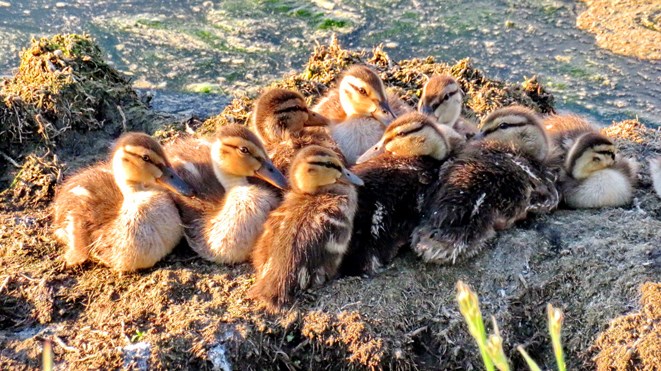Pip, pip, pipping, a small crack develops.
It may take a few hours, but the 24 days of development has led to this point. The environment is warm and the work required to break out ensures fitness.
The tooth keeps worrying the inside wall. The crack gets bigger.
Eventually the third of the housing breaks off and the inhabitant can break free. There are others in the same situation. Eventually, it will be joined by eight others.
The first day, they must dry off. They must make their way to some water very soon. Quiet sounds are made, a form of communication. There is a much bigger member here that looks safe.
They must stay close and follow the larger member. More communication and off they go, leaving the site that they had lived in for so long. They are walking, and hear load noises as they approach a cleared area of tar and gravel.
Large creatures are moving back and forth at tremendous speeds. You cannot tell when they are coming, but the noise helps to give an indication. The bigger member seems to want them to cross this 20-foot area.
The big member crosses and calls for the others to follow. As they cross, a distant noise can be heard, but this time the creature is stopping. It makes some kind of shrieking noise. A chance to cross quickly …
This is the time of year when the young of waterfowl like the Canada goose and mallard duck make their presence all too familiar.
The eggs have hatched and the young congregate close to the parent or foster parent bird. Sometimes large numbers of young collect together.
At Nepahwin Lake so far this year, there is a group of 23 young goslings that share the lake and its activities with human counterparts. Mallard families are seen on a regular basis at Fielding Park and Bell Park.
Mallards may lay their eggs in a nest as far as one mile from the nearest water. When the eggs hatch, in about 24 days, the young ducklings gather as a family and trek across country to the water of choice.
Crossing the roads can be hazardous, but alert drivers can allow these families a safe crossing to the water. Stories of duck families crossing roads and stopping traffic are pretty familiar.
Canada geese families can be a little different. In some areas, they cross as a group on a daily basis, which make the crossings a little more hazardous as they make their way from water to that fresh green lawn of grass shoots.
At this time of year, adult geese are almost flightless as they have lost their primary and secondary flight feathers and are now growing new ones. It takes about a month.
Keeping pets on leash close to park wetlands is a must this time of year. Young duck and geese families are wary of disruption, but a scattered panic can lead to lost or unprotected young birds.
Take the time to observe and enjoy the local waterfowl. The daily growth of the young shows a wealth of different behavioural traits and colours within the different species. Adults are moulting. Male mallards slowly lose their bright green head feathers and look more like females this time of year. They congregate in groups of males as the females stick to more private areas to protect and care for the young.
So when you’re out and about on local roadways, keep your eyes peeled for geese and ducks, and when you’re in local parks, please keep your dog on a leash to protect these young birds (and while you’re at it, consider belling your cat).
After all, no one wants to be responsible for breaking up a family, right?
Chris Blomme is an executive member of the Sudbury Ornithological Society and works with animals at Laurentian University. Have a question for Chris? Send it to [email protected].
